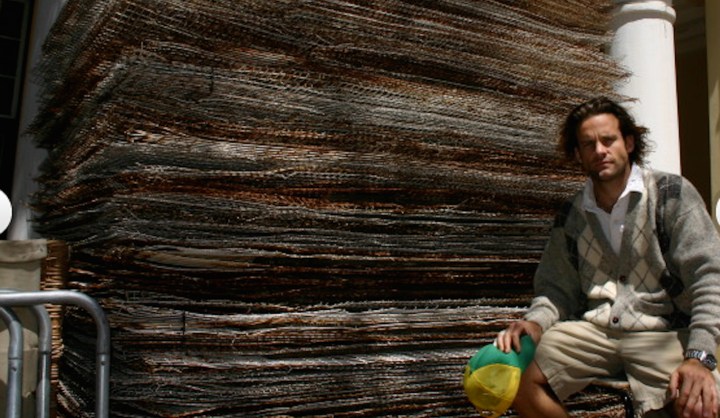Maverick Life
Robben Island fence art: Apartheid porn, political kitsch or salvaging history?

Call it Apartheid porn, call it political kitsch, call it crass commercialism, but we can’t deny that were it not for one man’s keen eye, the fence that once surrounded D Block Maximum Security Prison on Robben Island where Nelson Mandela and other political prisoners were incarcerated for much of their lives, would have ended up in a landfill where it would have rusted into oblivion. Instead, what some deemed a worthless piece of scrap is being turned into works of art and jewellery. But not everyone’s happy. By MARIANNE THAMM.
It’s the kind of story that triggers that atavistic “Damn, I wish that had happened to me” reflex that lurks deep within us. You know, like the incredible account of the Irish fisherman, Tony Varney, who came across a canvass of three seated women propped up near the gates of a rubbish dump in 1987 and which later turned out to be an authentic work by Winslow Homer, one of the foremost American painters of the 19th Century and worth a fortune.
And so it came to pass in 2009 that Cape Town artist Chris Swift, a graduate of the Michaelis Art School and a maker of art from found objects, accompanied his nephew and a few friends on an educational trip – crossing by ferry the choppy short stretch of ocean between Cape Town and Robben Island – to visit the UNESCO heritage site, once home to Nelson Mandela and other political prisoners for much of their incarcerated lives.
Swift, who is a sort of scavenger artist, has made works out of discarded bed springs, school desks, crutches, buckets and even condoms (see interview here) and “reinterprets those things that you have long since would not have given a second glance”.
Unlike the Berlin wall that was dismantled in full glare of banks of global television cameras, the demise of the original Robben Island fence was witnessed only by those tasked with its removal and replacement. It was, by all accounts, an entirely unremarkable and rather tedious event, one would imagine.
Was it serendipity, then, that as Swift and his party were about to depart the island, his magpie eye fell upon stacks of rusted and mangled fencing being folded up and loaded into a skip? Certainly had he not noticed the scrap it would have ended up being dumped at the Vissershok landfill just off the N7 highway where it was destined.
At the time Swift says that he thought to himself, “The guys are not throwing that stuff away, are they? I mean it is a UNESCO World Heritage site, and you can’t even take a pebble off the beach there.”
After a few phone calls, the artist learned that the 3m high fence had once surrounded Block D, the Maximum Security Prison, where Nelson Mandela, Walter Sisulu, Govan Mbeki, Tokyo Sexwale, Kgalema Motlanthe, Jacob Zuma and at least 3,000 other political prisoners were held since 1961 when Robben Island had been converted into a jail.
The fence that Swift witnessed being cut up and shipped off as worthless had once encircled and trapped the prisoners but he understood that it was imbued with deeper significance. The fence had also been a mute witness to history, to say nothing of the misery, the isolation and the whispered hopes and dreams of some of the most significant historical figures in the country’s recent past.
Swift says authorities were only too happy to hand the fence over so that he could have it removed. After shipping it back to Cape Town, the artist delivered it to a workshop in Stellenbosch where it was processed and cut up.

Photo: The fence being shipped back to Cape Town
He used sections for public art installations – a piece featuring 118 stacked segments and titled “Nelson’s Column” outside the City Hall in 2010 – and then later, a more light-weight version of the work where he used scaffolding clad with the fencing. Swift also built a replica of Nelson Mandela’s cell to scale from the fencing titled “The Pen Is Mightier than the Sword” and in 2010 donated a piece to the Apartheid Museum in Johannesburg.
The artist later formed the Robben Island Arts Company and Trust (RIACT), which acts as a “custodian” of the fence. Segments have been included in works by Swift as well as artists Marc Alexander and Chantelle Potgieter. Cape Town jeweller, Charmaine Taylor, was given the rights to create pieces of jewellery from off-cuts and which retail for between R3,000 and R7,000. Taylor, in keeping with Nelson Mandela’s vision no doubt, donates a percentage of the profits to a local NGO of organic farmers, Abalimi Basekhaya.

Photo: One of the artworks by Marc Alexander featuring an authenticated chunks of the fence.
So far spin-offs from the fence have proved highly popular. Two thousand special World Heritage Robben Island Fence gold medallions accompanied by two small, authenticated pieces of the fence and made available through Scoin (the retail division of the South African Gold Coin Exchange) sold out in a day.
Last month, the Presidency bought artwork, featuring sketches of former president Nelson Mandela by Alexander, as gifts for all the guests who attended President Jacob Zuma’s inauguration on 24 May.
But the fact that the Robben Island fence has been recycled and sold off as artwork and jewellery which trades on South Africa’s recent history or the iconic nature of some of the leaders featured in the work – including Desmond Tutu, Mandela, Albert Luthuli, Nkosi Johnson and (dare we say) FW De Klerk – has not been met with unanimous cheer.
Writing in City Press over the weekend, columnist Gugulethu Mhlungu argued, “It is difficult to not feel like this is another commodification of our history. In fact this is almost like Apartheid porn, where any bit of memorabilia associated with the history of oppression is turned into a cash cow. Sickening.”
Yvonne Johnston, former Brand SA CEO, who joined the Robben Island Fence Project as Marketing Director in February this year, disagrees.
“The question I would like to ask is what would have happened to the fence if it had not been salvaged? This is about a piece of our history and our heritage. It is something we should be proud of and use to keep the spirit, the values, the ethos and the ideals of those men who were imprisoned on Robben Island alive,” she said.
Johnston added that the project was still very new and would soon be expanding to include emerging artists who could become part of the collective which at present mostly features works by Alexander. A competition to encourage these younger, less established artists would soon be launched.
Apart from this, she said, the Robben Island Fence project would channel 10 percent of its turnover into the Awethu Foundation, which aims to encourage entrepreneurship in South Africa and which, according to Johnson “embodies Madiba’s vision of a socially just South Africa.”
That history can be turned into sellable artefacts or kitsch and commercial tourist curios should not surprise us. Totalitarian kitsch from the previous USSR enjoys widespread popularity, as do Chinese political objet d’art featuring Chairman Mao.
A website dedicated to selling off chunks of the Berlin Wall mounted on bits of wood markets itself thus: “Celebrate the victory of freedom over Communist tyranny with a genuine piece of the Berlin Wall mounted on a walnut plaque with a brass nameplate and a numbered certificate of authenticity.”
It was Leon Trotsky who popularised the expression “the trash heap of history” – a figurative place where individuals, ideologies or events become forgotten or marginalized, but that, of course, was long before global capitalism fine-tuned the ability to make sentimental history out of trash, or art, or anything else for that matter.
But the point about the fence is that it is a finite object, there is only so much of it and in a world measured by supply and demand, this gives it great investment value. Besides, there is no point denying the sentimental value of holding onto something physical and tangible as our history and some of the icons that made it, slips away.
Would Mandela have approved? Probably, as long as those human beings who benefit from the fence use it to uplift those who have been left behind. DM
Photo Main: Artist Chris Swift with sections of the Robben Island fence he rescued. (All photos http://www.robbenislandfence.com)















 Become an Insider
Become an Insider